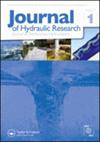基于机载激光雷达影像的复杂植被河廊洪水三维数值模拟
IF 1.7
3区 工程技术
Q3 ENGINEERING, CIVIL
引用次数: 2
摘要
在日本冈山县的朝日河上,历史悠久的引水堰在经过修缮后首次出现了洪水泛滥的情况。河流研究人员通过实验室研究和传统的二维(2-D)深度平均模拟,分析了分流流量的防洪措施。现有模型不足以模拟植被枝叶引起的流阻、河流廊道周围垂直流分布等现象。因此,我们通过机载光探测和测距(LiDAR)地形测深(ALB)数据估算地形、土地覆盖和植被分布,建立了三维(3-D)植被阻力多孔模型。结果表明,与时空图像测速(STIV)数据和现场测量结果相比,该方法的水位和流量状况的重现性优于参考二维计算。在现有的河床和植被条件下,采用该模型设计的引水流量是可行的。本文章由计算机程序翻译,如有差异,请以英文原文为准。
Three-dimensional numerical modelling of floods in river corridor with complex vegetation quantified using airborne LiDAR imagery
Excessive flood flow over the historic diversion weir in the vegetated Asahi River in Okayama Prefecture, Japan, was recently recorded for the first time after its renovation work. Fluvial researchers analysed the diversion discharge for flood mitigation measures through laboratory studies and conventional two-dimensional (2-D) depth-averaged simulations. The existing model was insufficient for simulation of certain phenomena such as flow resistance caused by vegetation branches and leaves and vertical flow distribution around the river corridor. Therefore, we developed a three-dimensional (3-D) vegetation resistance porous model by estimating topography, land cover, and vegetation distribution from airborne light detection and ranging (LiDAR) topo-bathymetry (ALB) data. Results show that the water level and flow regime were more reproducible than by referenced 2-D calculations when compared to space-time image velocimetry (STIV) data and field measurements. The diversion discharge designed using the proposed model is feasible with the current riverbed and vegetation conditions.
求助全文
通过发布文献求助,成功后即可免费获取论文全文。
去求助
来源期刊

Journal of Hydraulic Research
工程技术-工程:土木
CiteScore
4.90
自引率
4.30%
发文量
55
审稿时长
6.6 months
期刊介绍:
The Journal of Hydraulic Research (JHR) is the flagship journal of the International Association for Hydro-Environment Engineering and Research (IAHR). It publishes research papers in theoretical, experimental and computational hydraulics and fluid mechanics, particularly relating to rivers, lakes, estuaries, coasts, constructed waterways, and some internal flows such as pipe flows. To reflect current tendencies in water research, outcomes of interdisciplinary hydro-environment studies with a strong fluid mechanical component are especially invited. Although the preference is given to the fundamental issues, the papers focusing on important unconventional or emerging applications of broad interest are also welcome.
 求助内容:
求助内容: 应助结果提醒方式:
应助结果提醒方式:


